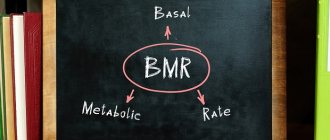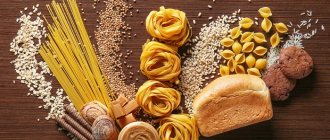© kentoh — depositphotos.com
Share:
Metabolism is an important puzzle in the picture or a milestone on the path to building a plan for losing weight or gaining muscle mass. By understanding the action of basic biochemical processes, it is easier to achieve your goals, regardless of your body type. Let's look at what it is - we'll explain it in simple language, without getting into the scientific jungle.
What it is?
Metabolism
is the processes that take place in any living organism to maintain its life.
Metabolism allows the body to grow, reproduce, heal damage, and respond to the environment. This really requires a constant metabolism
. Processes can be divided into two threads. One is destructive - catabolism, the other is creative - anabolism.
How to lose weight through sports?
Basic rules of training, diet and useful links in special material for those who want to lose weight.
Disassembly at the molecular level...
Any nutrient that enters the body cannot immediately be used for its needs. For example, proteins
from nuts, milk and human muscles are completely different and cannot replace each other.
However, they consist of the same “building blocks” - amino acids
.
Although each of the proteins has a different set and ratio. To obtain building material for, for example, biceps, special enzymes disassemble the protein contained in milk or cutlet into individual amino acids
, which are already used.
At the same time, energy is released, measured in calories. The process of disassembly is catabolism
. Another example of catabolism is the breakdown of regular refined sugar into fructose and glucose.
Types of muscle fibers[edit | edit code]
Skeletal muscles are made up of individual fibers called myocytes. Each myocyte includes many myofibrils, which are filaments of proteins (actin and myosin) that have the ability to connect with each other and stretch. Thanks to their interaction, the muscle shortens - this process is called contraction. Read more:
Types of muscle fibers
There is a generally accepted division of muscle fibers into two main types: slow twitch (type I) and fast twitch (type II); the latter are usually divided into type IIa and type IIb. They respond differently to training and physical activity, and each type of fiber has a unique ability to contract in a specific way. Human muscles contain a genetically determined combination of slow and fast fibers.
On average, most muscles used for movement contain approximately equal amounts of slow and fast twitch fibers.
Slow twitch fibers (type I)[edit | edit code]
Slow twitch fibers use oxygen more efficiently to produce energy (ATP) during continuous, sustained muscle contractions. They take longer to warm up than fast-twitch fibers, but can work longer before they fatigue, making them very useful for endurance athletes.
Read more:
Slow muscle fibers
Fast twitch fibers (type II)[edit | edit code]
Because fast twitch fibers use anaerobic metabolism to produce energy, they are much better at producing short bursts of force and speed than slow twitch fibers. But type II fibers fatigue more quickly. They produce roughly the same amount of work per contraction as slow-twitch fibers, they just do it faster. Hence their name. Having more fast-twitch fibers is an advantage in sprinting and strength sports that require explosive power.
Read more:
Fast muscle fibers
Muscle fiber types and athletic performance
Our inherent predominance of a certain type of muscle fiber can influence our innate propensity for a particular sport, as well as our speed and strength. This is usually the case with elite athletes who play sports that match their genetically determined body structure. It is known that sprinters have about 80% fast twitch fibers, and marathon runners have about 80% slow twitch fibers.
This raises a logical question: is it possible to change their ratio so that it meets the requirements of the chosen sport? Can a 50m freestyle swimmer be as good as an open water endurance swimmer? This question is still the subject of large-scale research, and there is still no clear answer to it. There is evidence that training can convert skeletal muscle fibers from fast to slow fibers, but further laboratory observations and experiments are needed to confirm.
... and assembly shop
It is not enough for the body to disassemble proteins from what it eats into amino acids. From them it is necessary to assemble new proteins
for the same biceps muscle.
Myths and truth about losing weight
Is it possible to lose a few kilos in one workout, are muscle stimulants useful, and other stories for the lazy.
Building complex molecules from smaller components requires energy.
It uses the same calories that the body received during the “disassembly”. This process is called anabolism
. A couple more clear examples of the work of the body’s “assembly shop” are the growth of nails and the healing of cracks in bones.
Where does fat come from?
If the process of breaking down nutrients produces more energy than is required for the construction of new body cells, there is a clear excess
that needs to be put somewhere.
When the body is at rest, metabolism occurs in the “background” mode and does not require active breakdown and synthesis of substances. But as soon as the body begins to move, all processes accelerate and intensify. The need for energy and nutrients also increases. But even an active organism may still have excess calories
if it comes in too much from food.
A small part of the received and unspent energy is stored in the form of glycogen
- a source of energy for active muscle work.
It is stored in the muscles and liver themselves. The rest accumulates in fat cells
. Moreover, their formation and life require much less energy than building muscles or bones.
The consequences of cutting calories
A sharp reduction in calories and strict diets negatively affect women’s metabolism and are quite easily tolerated by men. Representatives of the stronger sex, forced for one reason or another to reduce their diet to 30%, at such moments easily get rid of the fat layer and noticeably lose weight. The beautiful half of humanity, starving, on the contrary, can gain even more excess weight and completely undermine their health. A lack of calories in women provokes hormonal disruptions and disruption of the monthly cycle. The female body turns on accumulation mode and stores fat in case of another emergency hunger strike.
Low-calorie diets, which lead to health problems, are not recommended for women to lose weight. Proper nutrition with the correct daily calorie intake is the right path to a beautiful body.
How is metabolism related to body weight?
We can say that body weight is catabolism minus anabolism
.
In other words, the difference between the amount of energy entering the body and the amount used by it. So, one gram of fat eaten gives 9 kcal, and the same amount of protein or carbohydrate gives 4 kcal. The body will store the same 9 kcal into 1 gram of fat in its body if it fails to spend it. A simple example
: you eat a sandwich and lie down on the sofa. From bread and sausage, the body received fats, proteins, carbohydrates and 140 kcal. In this case, the lying body will spend the resulting calories only on breaking down the food eaten and a little on maintaining the functions of breathing and circulation - about 50 kcal per hour. The remaining 90 kcal will turn into 10 g of fat and be deposited in the fat depot. If a sandwich lover goes for a quiet walk, the body will burn the resulting calories in about an hour.
Principles of nutrition to normalize metabolism
Let’s take a closer look at diet and nutritional principles to normalize metabolism, because no amount of physical activity or vitamin and mineral supplements will help without the base – proper nutrition.
First of all, you need a proper balanced breakfast. A morning meal will provide energy for a long time, so it is important that breakfast consists of proteins, fats, and carbohydrates. Carbohydrates, especially complex ones, will provide satiety, fats will help launch bile flow and, accordingly, the entire digestion process.
Don't forget to drink water. Clean water removes waste and toxins from the body, and a couple of glasses of warm water on an empty stomach starts our body and helps it wake up. There are several options for calculating the required amount of fluid consumed: 30 ml per 1 kg of ideal weight, or 1 ml of water per 1 kcal of food consumed. If you drink a lot of coffee or black tea, remember to increase your water intake.
There is an opinion that frequent meals 5-6 times a day speed up metabolism and faster weight loss occurs. However, today, doctors and nutritionists are inclined to eat three meals a day in order not to cause unnecessary surges in glucose and insulin.
In addition, it is very advisable to eat protein foods every day, since the body requires a lot of time to absorb it and a lot of effort to digest protein. According to American nutritionists, the process of protein digestion activates the body's energy expenditure (that is, burning calories) almost twice. But there are also nuances here - good acidity of gastric juice and normal functioning of all enzymatic systems are necessary in order for the protein to be properly absorbed.
The diet should contain a lot of plant foods and fiber. As you know, vegetarians have an accelerated metabolism. At the same time, more energy is spent on raw foods. Include up to 80% plant foods in your diet. Fruits containing fruit acids and plant enzymes also allow you to lose extra pounds and help metabolism in the body. Grapefruit and lemon improve digestion, promote fat burning and speed up metabolism.
Targeted nutrition tips
that will increase your energy level by 10 out of 10
From TOP nutritionists of the MIIN
Get tips
Also, quite often, to speed up metabolism, nutritionists prescribe treatment table No. 8
. The general characteristic of this treatment table is to reduce the calorie content of the diet due to carbohydrates, especially easily digestible ones, and to a lesser extent fats (mainly animals) with a normal or slightly increased protein content. Restriction of free fluid, sodium chloride and appetite-stimulating foods and dishes. Increased dietary fiber content. Dishes are prepared boiled, stewed, baked. Fried, pureed and chopped products are undesirable. They use sugar substitutes for sweet dishes and drinks (xylitol and sorbitol are taken into account in the calorie content of the diet).
Compound
: proteins – 90-110 g (60% animal), fats – 80-85 g (30% vegetable), carbohydrates – 150 g, sodium chloride 5-6 g.
Calorie content
: 1700-1800 kcal.
Diet
: 5-6 times a day with enough volume to feel full.
Excluded foods and dishes:
- products made from premium and 1st grade wheat flour, butter and puff pastry;
- milk, potato, cereal, legume, and pasta soups;
- fatty meats, goose, duck, ham, sausages, boiled and smoked sausages, canned food;
- fatty types, salted, smoked, canned fish in oil, caviar;
- fatty cottage cheese, sweet cheeses, cream, sweet yogurt, fermented baked milk, baked milk, fatty and salty cheeses;
- fried eggs;
- cereals: rice, semolina and oatmeal, pasta, legumes;
- fatty and spicy snacks, sauces; mayonnaise, all spices;
- grapes, raisins, bananas, figs, dates, very sweet varieties of other fruits, sugar, confectionery, jam, honey, ice cream, jelly;
- grape and other sweet juices, cocoa;
- meat and cooking fats.
Recommended dishes:
- Bread and flour products
: rye and wheat bread made from wholemeal flour, protein-wheat and protein-bran bread - 100-150 g per day.
- Soups
: up to 250-300 g per meal, from various vegetables with a small addition of potatoes or cereals; cabbage soup, borscht, okroshka, beetroot soup. 2-3 times a week, soups in weak low-fat meat or fish broth with vegetables and meatballs.
- Meat and poultry
: up to 150 g per day. Low fatness beef, veal, rabbit, chicken, turkey, limited - lean pork and lamb - mainly boiled, as well as stewed, baked in large and small pieces. The meat is fried after boiling. Beef jelly, beef sausages.
- Fish
: low-fat types up to 150-200 g per day. Boiled, baked, fried, seafood.
- Low-fat milk and fermented milk drinks
. Sour cream - in dishes, low-fat cottage cheese with 9% fat content (100-200 g per day) - natural and in the form of cheesecakes, puddings. Low-fat cheese varieties - limited.
- Eggs
: 1-2 pieces per day, hard-boiled, protein omelettes, omelettes with vegetables.
- Cereals are only for adding to vegetable soups. Crumbly porridges from buckwheat, pearl barley, and barley due to the reduction of bread.
- Vegetables
They are used widely, in all forms, some of them always raw. All types of cabbage, fresh cucumbers, radishes, lettuce, zucchini, pumpkin, tomatoes, turnips are desirable. Sauerkraut - after washing. Limit dishes from potatoes, beets, green peas, carrots, rutabaga (total up to 200 g per day), as well as salted and pickled vegetables.
- Snacks
: salads from raw and pickled vegetables, vinaigrettes, vegetable salads with boiled meat and fish, seafood. Jellied fish or meat, lean ham.
- Fruits and berries of sweet and sour varieties, raw and boiled. Jelly and mousses based on methylcellulose, xylitol, sorbitol, unsweetened compotes.
- Sauces and spices
: tomato, red, white with vegetables, mild mushroom, vinegar.
- Beverages
: tea, black coffee and coffee with milk. Low-sweet fruit, berry, vegetable juices.
- Fats
: butter (limited) and vegetable oils - in dishes.
“Good” and “bad” metabolism?
Many look with envy at the fragile girl who regularly feasts on cakes and does not gain an ounce of weight. It is generally accepted that such lucky people have a good metabolism, while those for whom a piece of sugar in their tea threatens weight gain have a poor metabolism. In fact, research results show that truly slow metabolism is observed only in a number of diseases
, for example, hypothyroidism - a lack of thyroid hormone. And most overweight people do not have any diseases, but there is an energy imbalance. That is, much more energy enters the body than is actually needed, and it is stored in reserve.
What you need to know about metabolism
The entire life of an organism is a balance between the breakdown of nutrients and the production of energy from them and energy expenditure in the creation of new molecules and cells.
If too much energy is supplied, it is stored in reserve in the form of adipose tissue. You can increase energy expenditure by moving a lot or growing a sufficient amount of muscle mass. Tags:
- Women
- Men
- Metabolism
- Weight loss
1 comment • To leave a comment you must be an authorized user
- twatpw0tja0 Thanks for the article.
Accumulation of fatty deposits
The distribution of body fat in men and women differs significantly.
In women, fat is deposited subcutaneously. Men most often accumulate internal visceral fat, which envelops the abdominal organs. The dangers of internal abdominal fat :
- high risk of developing cardiovascular diseases;
- phlebeurysm;
- hormonal imbalances;
- the possibility of tumor development;
- Decreased insulin sensitivity can eventually lead to diabetes.











